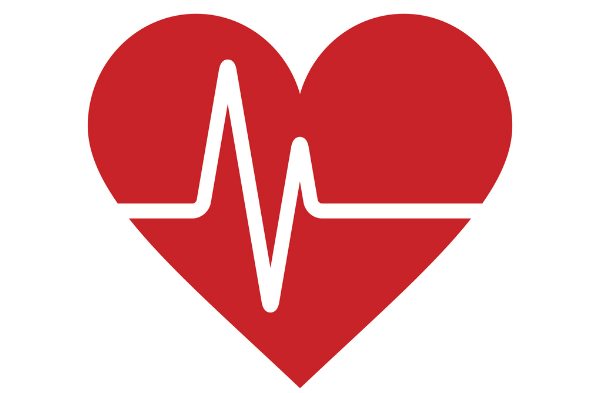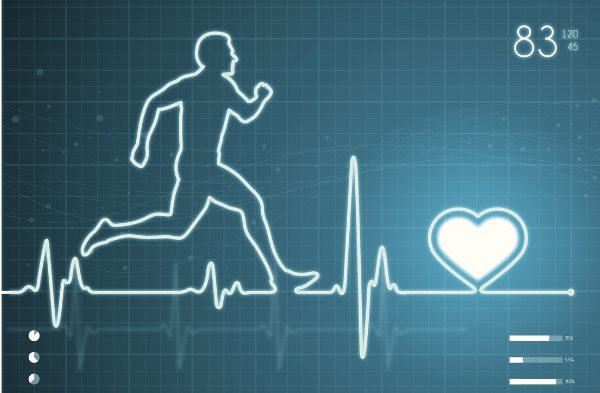What does 'heart training' mean?

Heart training refers to the idea of working out within a certain heart rate zone. Each of these zones can have a different effect on your health – for example, working out within specific zones can help you to burn fat, improve your anaerobic capacity, muscle strength and endurance.
Keeping an eye on your heart rate is also a realistic way to form objectives, rather than relying on your judgement. It gives you a more realistic view of what you are capable of and what you should be aiming for.
If you are working out within a specific zone, you should have an idea where your heart rate should be. If you are running at a certain speed on the treadmill and you notice that your heart rate is lower than anticipated, you can adjust your routine to elevate your heart rate and vice-versa.
How do I determine my heart rate zones?

So how exactly do you go about determining your heart rate zones? Well, the old fashioned way to get your maximum heart rate would have been to subtract your age from 220. Say you’re 30 years old – that would mean your maximum heart rate should be 190.
However, this isn’t always accurate so a lot of people are moving away from this method. Instead, the most popular method involves a little bit of mathematics so stay with me here.
First, you need to determine your rest heart rate (RHR) and your maximum heart rate (MHR), so get your hands on a heart monitor. I would suggest measuring your RHR first thing in the morning – you may need to do this several times to get an average.
Let’s say you discover your RHR is 55 beats per minute (bpm). Now you have to calculate your MHR. The best way to do this would be to go for a run – a very hard run. Sprint as fast as you possibly can, for as long as you can and get an average from your heart rate monitor. This should help to determine your MHR. In this example, your MHR is 195 bpm.
You now need to subtract your RHR from your MHR.
195 – 55 = 140 bpm, your working heart rate (WHR).
Once you have calculated your WHR, it’s time to take a look at your zones! You can determine your zones by taking a certain percentage of your WHR and adding it to your RHR to determine a figure.1
1http://www.twrc.rowing.org.uk/coach/heartrate.htm
What are the different training zones?

There are approximately 4 different zones that you can workout in, although you have to be careful and make sure you’re exercising within your capabilities. If you’re not a professional athlete, then working out too close to your maximum heart rate could be dangerous and have unpleasant consequences for your health and wellbeing.
1 – Recover zone: The first zone is known as the recovery zone. In this zone, your heart rate should be sitting between 60%-70% of your WHR added to your RHR. For example, if you’ve determined that your WHR is 140 bpm, it would look like this: 60-70% of 140 + 55 = 139-153 bpm.
This might be the slowest zone on the list, but you’d be wrong to overlook it. This zone is extremely good for weight loss – you will be burning fat rather than glycogen and it gets your muscles working. It develops endurance and gives your body a chance to reenergise, so really, do not underestimate this one!
2 – Aerobic zone: The next zone you need to think about is the aerobic zone, where your heart rate should be sitting between 70%-80% of your WHR + RHR. To fall back on my earlier example – if your WHR is 140 and your RHR is 55, your heart rate in this zone should be between 153 bpm and 167 bpm.
If you’re looking to increase your stamina and endurance, this is the zone for you. Working in this zone is great for your cardio and enhances your body’s ability to convey oxygen to your muscles. Not bad! If you’re trying to progress from the recovery zone to this zone, I would do so gradually and not all at once. Do a bit of interval training to get your body used to this new pace until you feel comfortable.
3 – Anaerobic zone: In this zone your heart rate should be sitting between 80%-90% of your maximum working heart rate. Again, for a person with a WHR of 140 and a RHR of 55, their heart rate would be sitting between 167 and 181 bpm in this zone.
Working out in this zone should help develop your lactic acid system and instead of burning fat, you will start to burn glycogen, which is stored in your muscles. However, your body may reach the point where it is no longer capable of getting glycogen (lactic acid) from your muscles. This is known as your anaerobic threshold, and you have probably experienced it before – think of a rapid and extreme increase in your bpm followed by slowing down.2
4 – Red zone: Be warned, unless you’re a professional athlete, you should not be working out within this zone for a prolonged period of time. As I mentioned earlier, it’s dangerous to be exercising so close to your maximum working heart rate and although you can develop speed in this zone, it’s definitely NOT for novices, or even those that regularly visit their gym and workout.
2http://www.twrc.rowing.org.uk/coach/heartrate.htm
What heart rate zone should I exercise in?

The heart rate zone you should be exercising in will very much depend on your own level of fitness and your objectives.
If you are relatively new to working out, I would recommend keeping within the recover zone until you improve your stamina and muscle strength. Remember, this is the fat-burning zone so
it may also be an idea to exercise in this zone if you are trying to lose weight!
However, if you are a more experienced runner or a keen cyclist training for a marathon, I would advise working out in the aerobic and anaerobic zones. In these zones you can really work on your endurance, speed and increasing your anaerobic threshold, ensuring you can  go faster and last for longer!
go faster and last for longer!
As for the red zone, I would stay away from here unless you really are a workout pro and even then, I would only suggest exercising in this zone for a little bit at a time.
If you find that you may have overexerted yourself in one of the zones, make sure you take the time recover properly. Allow your muscles to rest for a few days before returning to your normal workout routine, and even then, I would consider sticking to the recover zone for a little while.
If you notice any muscle pain, you could try our Atrogel Arnica Gel, a fast-acting solution that’s perfect for sport injuries and bruising. Prepared using extracts of freshly harvested arnica flowers, it’s extremely soothing and cooling, and best of all, it won’t interfere with any other medications, meaning you can keep applying it for as long as you need to!








